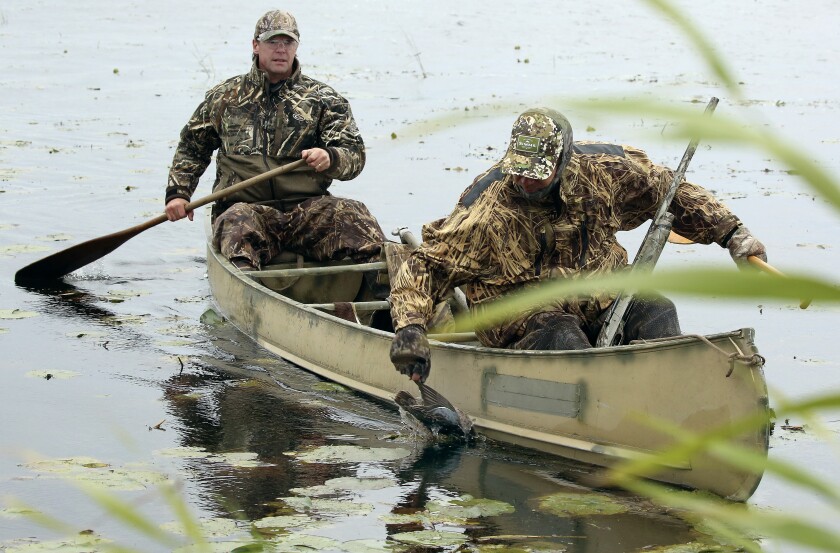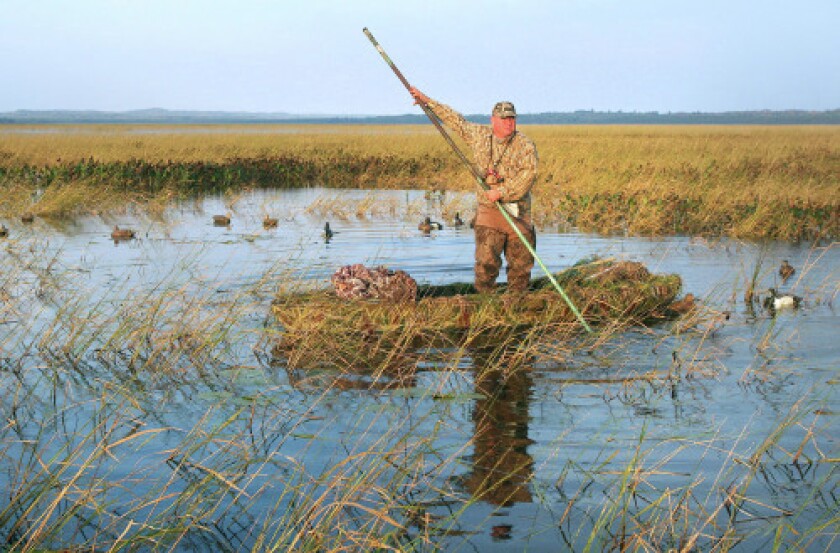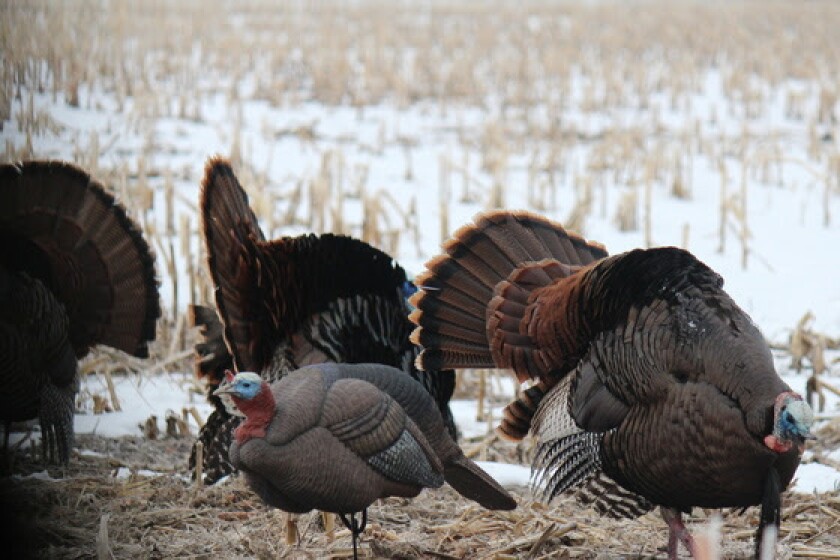BEMIDJI — For the first time in more than a half-century mallards were not the most common duck shot by Minnesota waterfowl hunters in 2022 — topped by both blue-winged teal and ring-necked ducks.
Mallards had been the most-harvested duck in the state since at least the 1960s, said Steve Cordts, waterfowl specialist for the Minnesota Department of Natural Resources, and it remains unclear exactly why mallard harvest numbers in the state are dropping.
ADVERTISEMENT
“Mallards have been No.1 forever, at least since the 1940s and maybe 50s when scaup (bluebills) were the most commonly harvested duck here,” Cordts said, adding mallards had never before trailed teal or woodies.
While wood duck harvest and teal harvest have generally been going up or been stable in recent years — and ring-necked ducks have always been a popular duck, especially in northern Minnesota — the number of mallards harvested has slowly moved down. Cordts had predicted several years ago that wood ducks likely would eventually top mallards in hunters’ bags in the state. But the addition of an early September teal-only duck season in the state propelled bluewings to the No. 1 spot instead.
The state’s wood duck harvest also declined markedly in 2022, but still just missed pushing mallards down to the No. 4 spot.
According to data based on hunter surveys conducted by the U.S. Fish and wildlife Service, Minnesota hunters in 2022 harvested:
- 125,812 blue-winged teal, up from 81,170 in 2021
- 71,703 ring-necked ducks, up from 28,507 in 2021
- 63,072 mallards, down from 84,070 in 2021
- 62,076 wood ducks, down from 83,587 in 2021

The 63,000 mallards shot last year is down nearly 80% from the highest harvest levels over 300,000 per year in Minnesota during some years in the 1970s and just a fraction of the 435,000 mallards shot in Minnesota in 1967. And, in addition to dropping out of the No. 1 spot, the 2022 mallard harvest was also the lowest in Minnesota since accurate records have been kept, Cordts noted.
Habitat availability and quality remain ongoing issues, with fewer wetlands and grasslands available for ducks to nest in historic duck-producing areas of Minnesota.
Part of the problem may also be an historic shift that’s occurred in recent decades in both when and where northern ducks fly south. It seems more ducks are avoiding Minnesota during their migration, at least when most hunters are in the field.
ADVERTISEMENT
“Across the continent, mallard numbers are down a little this year. But they have been pretty stable in Minnesota as far as nesting ducks, so it’s not clear why our hunter harvest keeps dropping,” said Cordts, who is based in Bemidji. “Maybe it’s a case of the northern ducks coming down later in the fall because it’s freezing later up there, and then they fly right over us (Minnesota) because it’s also frozen here? We really don’t have an answer.”
The number of estimated waterfowl hunters, based on the sale of state waterfowl stamps required to hunt, had risen slightly to about 87,000 during the pandemic rush to get outdoors, Cordts noted, but fell back to pre-pandemic levels of about 80,000 in 2022. That number has been fairly stable for about a decade, Cordts noted, but is less than half the historic number of duck hunters from 50 years ago. Stamp sales so far this year are about 10% down from last year.

Season forecast: Ample ducks, but drought may impact hunter access
Early reports from the September teal season and youth waterfowl season are that Minnesota is holding a decent number of “local” ducks and that northern reaches of the state have seen an influx of early migrant Canada geese ahead of Minnesota’s Sept. 23 general waterfowl hunting season opener.
“The teal reports were pretty good, better in the south than the north … and people are seeing a big influx of molt-migrators (young Canada geese migrating south from their summering grounds in Canada) the last few days,” Cordts said. “Thief Lake (in northwestern Minnesota) is just full of wigeon and other ducks already, so that's a good sign.”
Cordts cautioned that a hard cold snap could push many local ducks out of the state. So far that's not in the forecast.
“I really hope we don’t get a rush of temperatures in the 20s the day before the season starts, because that can push the teal and wood ducks out very quickly,” he said. “I’ve seen it happen overnight. They just leave.”
ADVERTISEMENT
Don’t expect to go to the same spot you've been hunting for 20 years because it’s probably going to look a lot different this year.
Extremely low water levels in some lakes, sloughs and rivers may make it tough for hunters to get to where the ducks are. While ducks can be happy in just a few inches of water, it’s hard for hunters to get to those spots in boats or canoes.
Cordts warned hunters to “do some scouting before opening day to make sure you can get to where you want to go, because water levels are very low across the state. Don’t expect to go to the same spot you've been hunting for 20 years, because it’s probably going to look a lot different this year.”
Cordts said Minnesotans may see a smaller "northern flight" later in the season, because very dry nesting conditions across much of Canada likely produced fewer ducks.
In the Duluth area, DNR wildlife manager Chris Balzer in Cloquet said hunters should look to wild rice beds to find ducks.
“Most places have really good rice crops this year and I suspect many of the ducks are concentrated in the rice beds, but it is hard to see them in the rice,” Balzer said. “Given that, it is hard to comment on duck numbers much, but I suspect there are good numbers of birds in the good habitat. I think access will be OK. Most of the shallow lakes and wetlands are a little low, but there should be enough water for duck hunting access.”
Minnesota's duck season starts a half-hour before sunrise on Sept. 23 and runs continuously through Nov. 21 in the north and through Nov. 26 in the central and south, with a five-day closure in those zones from Oct. 2-6.
The daily limit is six ducks with no more than four mallards (two hen mallards), three wood ducks, two redheads, two canvasbacks, two black ducks, one pintail. One scaup may be taken per day through Oct. 12; tao scaup per day through the remainder of the season in each zone. For all other species, such as teal or ring-necked ducks, up to six ducks of a species may be taken daily.
ADVERTISEMENT
North Dakota duck numbers high
North Dakota-raised ducks were about 23% above last year’s numbers based on observations from the state’s annual mid-July duck production survey.
The number of broods observed during the department’s July brood survey was up 79% from 2022 and 88% above the 1965-2022 average index.
According to Mike Szymanski, migratory game bird management supervisor for Game and Fish in Bismarck, the department’s 76th annual breeding duck survey conducted in May indicated the 2023 duck index was the 23rd-highest on record, up 1.5% from 2022, and exceeded the 1948-2022 average index by 39%.



















